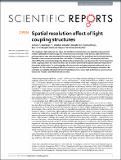Files in this item
Spatial resolution effect of light coupling structures
Item metadata
| dc.contributor.author | Li, Juntao | |
| dc.contributor.author | Li, Kezheng | |
| dc.contributor.author | Schuster, Christian | |
| dc.contributor.author | Su, Rongbin | |
| dc.contributor.author | Wang, Xuehua | |
| dc.contributor.author | Borges, Ben-Hur V. | |
| dc.contributor.author | Krauss, Thomas F. | |
| dc.contributor.author | Martins, Emiliano R. | |
| dc.date.accessioned | 2016-06-16T23:33:25Z | |
| dc.date.available | 2016-06-16T23:33:25Z | |
| dc.date.issued | 2015-12-18 | |
| dc.identifier | 243431341 | |
| dc.identifier | 02923faa-347b-4a9c-83ba-4e96799d18d3 | |
| dc.identifier | 000367055800001 | |
| dc.identifier | 84950241304 | |
| dc.identifier.citation | Li , J , Li , K , Schuster , C , Su , R , Wang , X , Borges , B-H V , Krauss , T F & Martins , E R 2015 , ' Spatial resolution effect of light coupling structures ' , Scientific Reports , vol. 5 , 18500 . https://doi.org/10.1038/srep18500 | en |
| dc.identifier.issn | 2045-2322 | |
| dc.identifier.uri | https://hdl.handle.net/10023/9003 | |
| dc.description | This research project was founded by the National Council for Scientific and Technological Development (CNPq) of Brazil (302397/2014-0), by the National Natural Science Foundation of China (11204386, 11411130117, 11334015), by the Open research project of the State Key Laboratory of Optoelectronic Materials and Technologies, Sun-Yat Sen University of China (OEMT-2015-KF-12, OEMT-2015-KF-13) and by EPSRC of U.K. under grant EP/J01771X/1 (Structured Light). Kezheng Li is also supported by the aboard exchange scholar and international doctoral cooperative project of Sun Yat-sen University. | en |
| dc.description.abstract | The coupling of light between free space and thin film semiconductors is an essential requirement of modern optoelectronic technology. For monochromatic and single mode devices, high performance grating couplers have been developed that are well understood. For broadband and multimode devices, however, more complex structures, here referred to as "coupling surfaces", are required, which are often difficult to realise technologically. We identify general design rules based on the Fourier properties of the coupling surface and show how they can be used to determine the spatial resolution required for the coupler's fabrication. To our knowledge, this question has not been previously addressed, but it is important for the understanding of diffractive nanostructures and their technological realisation. We exemplify our insights with solar cells and UV photodetectors, where high-performance nanostructures that can be realised cost-effectively are essential. | |
| dc.format.extent | 7 | |
| dc.format.extent | 948297 | |
| dc.language.iso | eng | |
| dc.relation.ispartof | Scientific Reports | en |
| dc.subject | QC Physics | en |
| dc.subject | NDAS | en |
| dc.subject.lcc | QC | en |
| dc.title | Spatial resolution effect of light coupling structures | en |
| dc.type | Journal article | en |
| dc.contributor.sponsor | EPSRC | en |
| dc.contributor.sponsor | EPSRC | en |
| dc.contributor.sponsor | EPSRC | en |
| dc.contributor.institution | University of St Andrews. School of Physics and Astronomy | en |
| dc.identifier.doi | https://doi.org/10.1038/srep18500 | |
| dc.description.status | Peer reviewed | en |
| dc.identifier.grantnumber | EP/H00680X/1 | en |
| dc.identifier.grantnumber | EP/J01771X/1 | en |
| dc.identifier.grantnumber | EP/J01771X/1 | en |
This item appears in the following Collection(s)
Items in the St Andrews Research Repository are protected by copyright, with all rights reserved, unless otherwise indicated.

